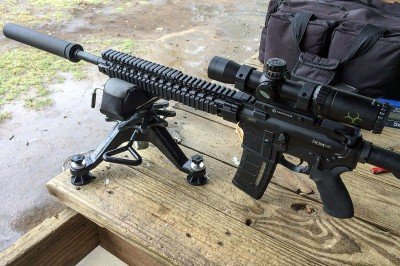
Recently when I wrote a review of the Daniel Defense DDM4v5 300 Blackout rifle, I mentioned that I’d be doing a drill down series on different aspects of the 300 AAC Blackout. Well, it starts here.
Love it or hate it, the 300 AAC Blackout is an interesting and incredibly diverse cartridge. Imagine trying to design a ballistic compensation scope for a cartridge that can use 110 grain projectiles traveling at 2,400 feet per second AND 245 grain projectiles traveling at 950 feet per second. That last one is somewhat like throwing a brick with much vigor.
This is going to be fun. Let’s dig in with some talk about the cartridge, basic ballistics and reloading for the 300 AAC Blackout.

The physics ’n math stuff
I’m a professional goofball, so I never really got physics. I made it through, but I never really understood concepts like acceleration, momentum and why mass is different than weight. So when it comes to looking at cartridge energy and recoil figures, I always rely on my friend Andrew Chamberlain. He apparently did get physics and he really likes guns. He likes both topics so much that he wrote the Cartridge Comparison Guide. In that book, you can compare pretty much anything about any cartridge to anything else about any other cartridge. If you’re a gun geek, get a copy!
If you do a rough comparison of muzzle energy of the 300 AAC Blackout to the 7.62×39 (AK-47) round, you’ll see a slight edge to the AK with a 100 grain bullet. The 110 grain Blackout at 2,375 feet per second yields 1,377.4 foot-pounds of muzzle energy to the AK’s 1,650.8 at 2,600 feet per second. When it comes to recoil energy, assuming you’re using an 8 pound rifle, the Blackout hits you less with 4.3 foot-pounds compared to the AK’s 6.34 foot-pounds.
But the 300 AAC Blackout isn’t supposed to compete directly with the AK. It’s supposed to offer a .30 caliber alternative with more short barrel terminal performance than the .223 Remington round. If you look at the “standard” 55 grain .223 Remington at 3,240 feet per second, that yields 1,281.8 foot-pounds of muzzle energy and 3.16 foot-pounds of recoil energy. And the Blackout makes a bigger hole.
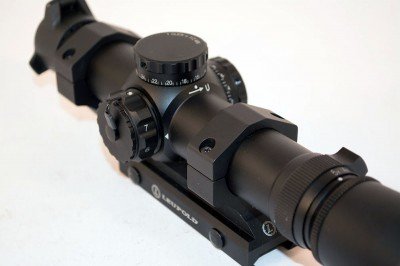
Shoots flat enough OR like a brick!
We’ve already hinted at the incredibly broad range of bullet weight and velocity that can be successfully fired from the same gun. Want supersonic? No problem. Buy some 100 or 125 grain ammo that will move along at up to 2,400 feet per second. Feel like something more moderate? No problem. .30 caliber bullets are available in all weights. You can get something in the 150 to 168 grain range that will move in the 1,700 to 2,000 feet per second range. Or you can get crazy and go full subsonic from the same AR platform rifle. How about a 208, 220 or even 245 grain projectile moving at 1,000 feet per second or less?
Of course, all of these options will have incredibly diverse trajectories, and that’s what gives scope makers fits over the 300 AAC Blackout. We’ll talk about that in detail next week. For now, let’s just look at bullet drop. We’ll consider scope adjustment for a 50 yard zero range using an optic that is 2.5 inches above the bore.
On the supersonic side, let’s compare bullet drop of a “300 Blackout specific” projectile like the Barnes TAC-TX 110 grain bullet to a 55 grain .223 Remington projectile traveling at 3,240 feet per second.
300 AAC Blackout 110 Grain Barnes TAC-TX, 2,350 fps .223 Remington 55 grain, 3,100 fps
100 yards +0.73 +1.57
200 yards -4.18 +1.43
300 yards -19.77 -4.16
400 yards -49.55 -16.87
500 yards -98.14 -39.06
When it comes to subsonic performance, the 300 AAC Blackout has no direct competitor. Like I said, it’s a thrown brick. But it’s insanely cool, quiet and useful at ranges of 100 yards or less. If you look at the trajectory of a 220 grain Sierra MatchKing fired at 1,023 feet per second, also zeroed at 50 yards, you’ll see the following.
300 AAC Blackout 220 Grain Sierra MatchKing, 2,350 fps
100 yards -6.09
150 yards -21.06
200 yards -45.21
500 yards -399.13
Clearly the subsonic loadings are not intended for long range use, although it might serve as an exceptionally lightweight mortar.

Adventures in reloading!
If you reload ammunition, getting a 300 AAC Blackout rifle may very well ruin your family life. There’s entirely too much tinkering potential. With the broad range of bullet weights and velocities, you may never settle on your own standard load.
I’ve only recently started tinkering with 300 Blackout loads and have already loaded and tested over 40 different projectile, powder and charge combinations, and I’m just getting started.
To narrow things down, lets talk about ideal projectiles and powders. First, you need to find projectiles compatible with .223 magazines. The ribs on .223 magazines are sized to support the necks on .223 / 5.56mm cartridge cases. Since the 300 AAC Blackout uses a cut down case, the ribs will be supporting the bullet itself, so the projectile has to be consistent with the expected dimensions, else feeding reliability will suffer.
Generally speaking, long, pointy bullets seem to work best. If the bullets are too short, feeding can be problematic. If they are too large in diameter at the position of the magazine ribs, feeding can also be impacted.
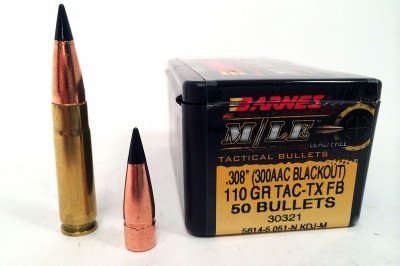
The Barnes TAC-TX is a perfect example of a projectile designed specifically for the 300 AAC Blackout. It’s on the lighter side of the range of 300 AAC Blackout bullets, so it’s intended for the higher end supersonic performance. I’ve also has near perfect success with Sierra MatchKing bullets in 125 and 135 grain weights. 125 grain Nosler Ballistic Tips and 125 grain Hornady SST bullets are also a great 300 Blackout solution.
In terms of powder choices, you’ll use powders in the faster half of the burn rate spectrum, like H110, Lil Gun, Accurate 1680 and IMR 4227. Fortunately, most of these are readily available. Accurate 1680 seems to the best option for subsonic loads as it creates more gas volume for reliable cycling. Unfortunately, that’s the one near impossible to find recently.
Brass availability depends on your desire to be industrious. By design, the cartridge case is identical to that at the .223 Remington, with the exception of being trimmed to a shorter length and reshaped to fit the .30 caliber bullet. You can buy ready-to-go 300 Blackout brass or you can make your own from .223 brass. The process is too much to go into here, but it’s not that big a deal.
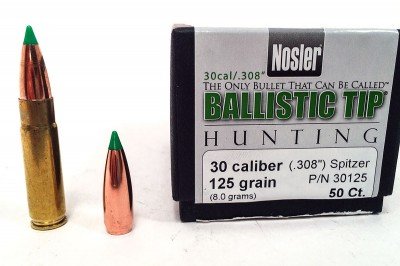
Accuracy and velocity tinkering
Tinkering is the key word here, as performing a methodical approach to determine the most accurate combinations of loads would take centuries. Do the math to calculate the total number of combinations of:
• A half dozen primer types
• A half dozen powder types
• 10 or 12 powder quantities for each type of powder
• A couple of dozen projectile weights
• Minute variations in bullet seating depth
Let’s see… dozens, times dozens, times dozens carry the one… I count 17 billion load combinations required to do a full velocity and accuracy analysis. That wasn’t feasible in my time frame, plus in have a short attention span, so I made a bunch of loads with somewhat impulsive combinations of bullets, powder and charge. I used CCI 400 small rifle primers for all of them to cut out at least one variable. Here’s what I found.
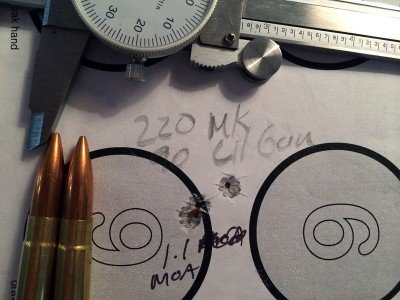
But first, NEVER, EVER, EVER RELY ON LOAD DATA FROM SECONDHAND SOURCES LIKE THIS ARTICLE. Only use load data from a printed manual from a reputable manufacturer. I’m only sharing this load information here for illustrative purposes to point out the diversity of the 300 AAC Blackout. I can’t be responsible for typos or other errors here. When reloading, always obtain your load data directly from the source. Safety first folks!
All groups in the table below reflect 3 shots and are shown in minutes of angle. If you’re not familiar with that, a minute of angle is just over one inch at 100 yards, so, for example, 1.5 MOA is just about a 1.5 inch group at 100 yards.
For the testing rifle, I used a Daniel Defense DDM4v5 300 AAC Blackout. I reviewed this rifle at the beginning of this series – you can read about it here. I used a Leupold Mark 4 MR/T 1.5-5x20mm optic for all accuracy testing.
Projectile Powder Charge (grains) Average Velocity (feet per second) Group size, MOA
110 grain Barnes TAC-TX H110 19.5 2,377 1.0
125 graIn Sierra MatchKing H110 18.0 2,146 0.94
125 grain Nosler Ballistic Tip IMR 4227 17.5 1,971 1.42
125 grain Hornady SST IMR 4227 18.3 2,085 1.3
125 grain Nosler Ballistic Tip H110 17.5 2,150 1.37
125 grain Nosler Ballistic Tip Lil’ Gun 17.5 2,198 1.74
135 Grain Sierra MatchKing H110 18.2 2,135 1.12
135 Grain Sierra MatchKing IMR 4227 18.3 2,075 N/A
135 Grain Sierra MatchKing Lil’ Gun 17.5 2,093 1.42
150 grain Sierra MatchKing Lil’ Gun 16.0 1,922 1.86
168 grain Sierra MatchKing Lil’ Gun 14.8 1,799 1.56
220 grain Sierra Matchking Lil’ Gun 9.0 1,149 1.1
245 grain lead RNFP IMR 4227 8.8 1,033 N/A
245 grain lead RNFP H110 8.6 1,107 N/A
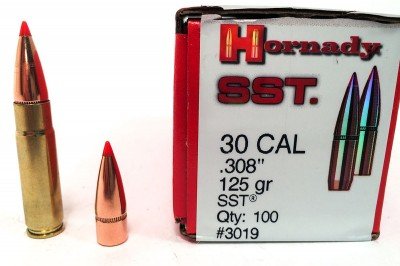
Just for kicks, I tested a few factory loads for velocity and accuracy too:
Load Velocity (feet per second) Accuracy (MOA)
110 grain Hornady V-MAX 2,435 2.45
208 grain Gorilla Ammunition (A-MAX) 1,038 1.52
245 grain Cooper Cartridge Hard Cast 1,058 N/A
As you can see, you could spend the rest of your life testing different iterations within this caliber. I didn’t do any type of formal ladder testing with powder charge increments and I didn’t even get into varying primer types and seating depth.
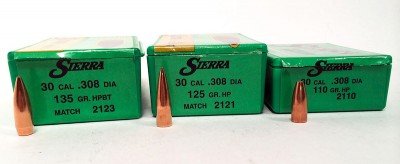
The bottom line
One of the biggest complaints about the 300 AAC Blackout cartridge is the cost and limited availability of factory ammunition. It’s more expensive than .223 / 5.56mm and much harder to find. I get that. But I also don’t see the 300 AAC Blackout as an either / or replacement for .223. It’s a different caliber with its own merits.
On the other hand, if you’re a reloader, it’s a tinkerer’s paradise. If you get crafty and learn how to cut down your own brass from .223 Remington cases, you have an infinite supply of cheap brass. Projectiles are also readily available as .308 inch diameter bullets are used in all sorts of rifles.
The bottom line? Celebrate diversity and try it out! We have more to come on the 300, so stay tuned.